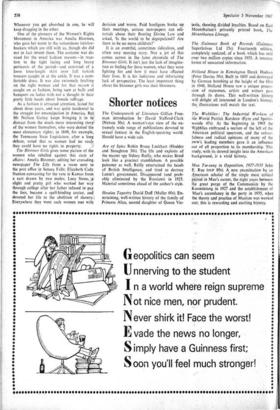Shorter notices
The Undergrowth of Literature Gillian Free- man introduction by - David Stafford-Clark (Nelson 30s). A woman's-eye view of the ex- tremely wide range of publications devoted to sexual fantasy in the English-speaking world. Should have a wide sale.
Ace of Spies Robin Bruce Lockhart (Hodder and Stoughton 30s). The life and exploits of the master spy Sidney Reilly, who makes Bond look like a precinct stumblebum. A possible poisoner as well, Reilly entertained the heads of British Intelligence, and tried to destroy Lenin's government. Disappeared (and prob- ably eliminated by the Russians) in 1925. Material sometimes ahead of the author's style.
Hessian Tapestry David Duff (Muller 60s). En- tertaining, well-written history of the family of Princess Alice, second daughter of Queen Vic- term, showing divided loyalties. Based on Earl Mountbatten's privately printed book, The Mountbatten Lineage.
The Guinness Book of Records (Guinness Superlatives Ltd 15s). Fourteenth edition, completely updated, of a book which has sold over two million copies since 1955. A treasure house of unwanted information.
Mao Tse-tung in Opposition, 1927-1935 John E. Rue (ouP 80s). A new examination by an American scholar of the single most critical period in Mao's career, the eight years between the great purge of the Communists by the Kuomintang in 1927 and the establishment of Mao's ascendancy in the party in 1935, when the theory and practice of Maoism was worked out; this is rewarding and exciting history. Holland House in Kensington Derek Hudson (Peter Davies 50s). Built in 1605 and destroyed by German bombing at the height of the blitz in 1940, Holland House saw a unique proces-
- siop of statesmen, artists and writers pass through its doors. This well-written history will delight all interested in London's history; ths.illustrations well match the text.
The Wobblies : The Industrial Workers of the World Patrick Kershaw (Eyre and Spottis- woode 45s). At the beginning in 1905 the Wobblies embraced a section of the left of the American political spectrum, and the colour- fulness and radical opinions of many of the tww's leading members gave it an influence out of all proportion to its membership. This study, with its shrewd insight into the American background, is a vivid history.










































 Previous page
Previous page